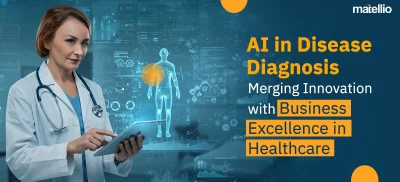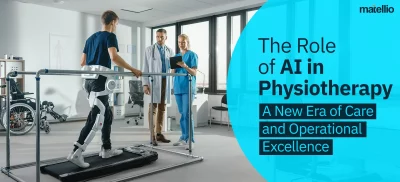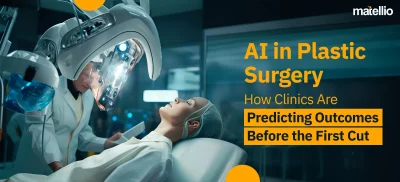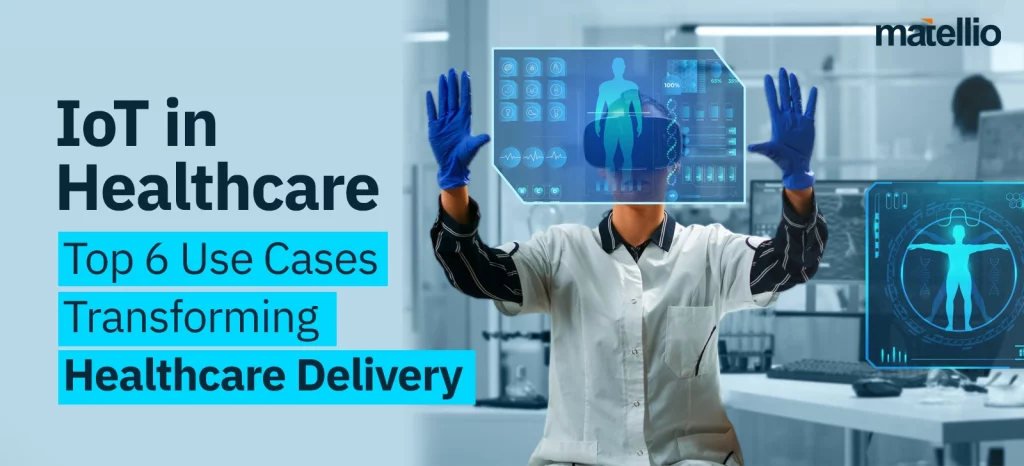
Did you know, the global market for IoT in healthcare is projected to hit a staggering $243.4 billion by 2025 — and that’s not just devices and dashboards. It’s smarter patient care, streamlined operations, and billions in potential cost savings. Even more eye-opening? The Internet of Medical Things (IoMT) is expected to save the healthcare industry over $300 billion by enabling real-time monitoring, predictive insights, and reduced hospital readmissions.
So, here’s the real question — where does your healthcare organization stand?
- Are your devices talking to each other, or are you still tracking vitals with pen and paper?
- Are your clinicians getting real-time data at the point of care — or hunting through outdated records?
- Is your hospital leveraging the applications of IoT in healthcare to improve outcomes, or just reacting when it’s too late?
- What could you save — in both lives and costs — if you had smarter systems working round-the-clock?
This is the difference between traditional care and intelligent, connected care. The difference between lagging behind and leading the charge.
If you’re not already exploring the benefits of IoT in healthcare, now’s the time to catch up. The tech is here. The proof is overwhelming. And competitors are already integrating IoT development services to transform how they operate and deliver care.
Let’s walk through the real-world IoT in healthcare use cases that are reshaping the industry — and how you can start tapping into them.
Top 6 Real-World Use Cases of IoT in Healthcare You Can Start Implementing Today
You’ve seen the stats. You’ve felt the pain points. Now let’s talk solutions — the actual applications of IoT in healthcare that are helping hospitals and clinics like yours cut costs, improve care, and stay competitive.
These aren’t abstract concepts. These are real, deployable use cases that you can implement with the right IoT development services — and start seeing results within months, not years.
Let’s break them down.
Remote Patient Monitoring (RPM): Real-Time Care Beyond Hospital Walls
Imagine this: A cardiac patient is discharged after surgery. Instead of sending them home with just instructions and hoping for the best, you send them with an IoT-enabled wearable that monitors their vitals — heart rate, oxygen levels, blood pressure — and alerts your clinical team in real time if anything goes sideways.
That’s Remote Patient Monitoring (RPM) — and it’s already transforming how forward-thinking hospitals operate.
According to NCBI, Remote Patient Monitoring can reduce hospital readmissions by up to 76% for some chronic conditions.
Here’s how it works:
- IoT devices like smart wearables or Bluetooth-enabled monitors continuously collect patient data.
- This data flows securely into your hospital’s system via the cloud.
- Clinical staff are notified instantly about irregularities — allowing them to intervene before things get critical.

(Source: MDPI)
What does that mean for you?
- Fewer readmissions and faster recovery — because patients are monitored proactively.
- Reduced burden on your staff, who now focus on intervention instead of observation.
- Improved chronic disease management, especially for cardiac, diabetic, and respiratory patients.
- Real-time alerts can be integrated with your EHR system — making IoT applications in healthcare part of your existing workflow.
This is no longer a futuristic perk — it’s a must-have. RPM is one of the most practical and high-impact IoT in healthcare use cases with immediate ROI and patient satisfaction benefits.
Mobile Health (mHealth): Your Hospital in Every Patient’s Pocket
Here’s a simple truth: patients expect digital healthcare access. They’re used to ordering groceries with one tap, so why are they still calling a receptionist for appointments or waiting days for lab results?
Mobile health, or mHealth, is one of the most accessible and scalable IoT applications in healthcare — and it’s revolutionizing how providers connect with patients beyond hospital walls.
Over 350,000 mHealth apps are available today — and the market is projected to grow at a CAGR of 14.1% from 2024 to 2030.
Here’s how it works:
- Patients use mobile apps integrated with IoT devices — wearables, smart inhalers, glucose monitors, etc.
- These apps collect, store, and transmit patient vitals in real time.
- The data syncs with your hospital systems or provider dashboards, enabling remote consultation, real-time alerts, and ongoing patient engagement.
It’s not just “nice to have” anymore. mHealth delivers measurable outcomes:
- 24/7 patient monitoring without the need for constant hospital visits.
- Better management of chronic conditions through continuous feedback loops.
- Faster response times in emergencies — with real-time alerts from connected devices.
- Lower hospital congestion by shifting routine interactions to virtual care.
mHealth apps can support:
- Medication reminders
- Sleep and activity tracking
- Virtual consultations
- Pregnancy monitoring
- Post-op recovery monitoring
- Personalized care content and instructions
So, the question isn’t “Should we have an mHealth strategy?” — it’s “Why don’t we already?”
If your facility isn’t already offering custom mobile IoT healthcare solutions, your patients will find a provider that does.
Enhanced Chronic Disease Treatment: From Reactive to Predictive Care
Chronic conditions — like diabetes, hypertension, COPD, and heart disease — account for over 85% of total healthcare costs globally. And here’s the kicker: most of these conditions can be better managed, or even prevented, with continuous data and smarter interventions.
That’s where IoT in healthcare truly shines.
With IoT-enabled wearables, connected home devices, and mobile apps, hospitals can now:
- Track vital signs 24/7 — blood sugar, heart rate, oxygen levels, and more.
- Identify health deterioration early, before it turns into a costly ER visit.
- Create personalized care plans based on real-time trends, not outdated reports.
- Engage patients remotely — especially those in rural or underserved areas.
This isn’t just convenient — it’s lifesaving. These are the benefits of using IoT in healthcare that matter.
Let’s say you have a diabetic patient enrolled in a remote care program:
- They wear a continuous glucose monitor connected to a mobile app.
- The device feeds real-time data to your hospital’s dashboard.
- If their levels spike or drop, your care team gets an alert and intervenes before complications occur.
Platforms like Health Net Connect and devices like Fitbit and Apple Health are already doing this — and hospitals that don’t adopt similar solutions risk being left behind in patient loyalty and outcomes.
This is the impact of IoT in healthcare that transforms chronic care from reactive to predictive, personalized, and proactive.
Let Matellio Help You Build a Secure and Scalable IoT Healthcare Platform Tailored to Your Needs. Contact Us Today!
Tracked Ingestible Sensors: Turning the Human Body into a Real-Time Data Stream
Now, what if you could literally track what’s happening inside the patient’s body — in real-time — without invasive procedures?
That’s exactly what ingestible IoT sensors do. These pill-sized, FDA-approved devices are made from biocompatible materials and packed with microprocessors, pH sensors, and transmitters. Patients simply swallow them like any regular pill — and the data starts flowing straight to your system.
The market for ingestible sensors is booming — it’s expected to reach over $1.9 billion by 2032.
How does IoT work in healthcare with ingestible?
- Once ingested, the sensors measure metrics like pH levels, core temperature, and pressure inside the GI tract.
- The data is wirelessly transmitted to a secure dashboard or app monitored by your care team.
- You get immediate insights into medication adherence, internal conditions, and anomalies — all without lifting a scalpel.
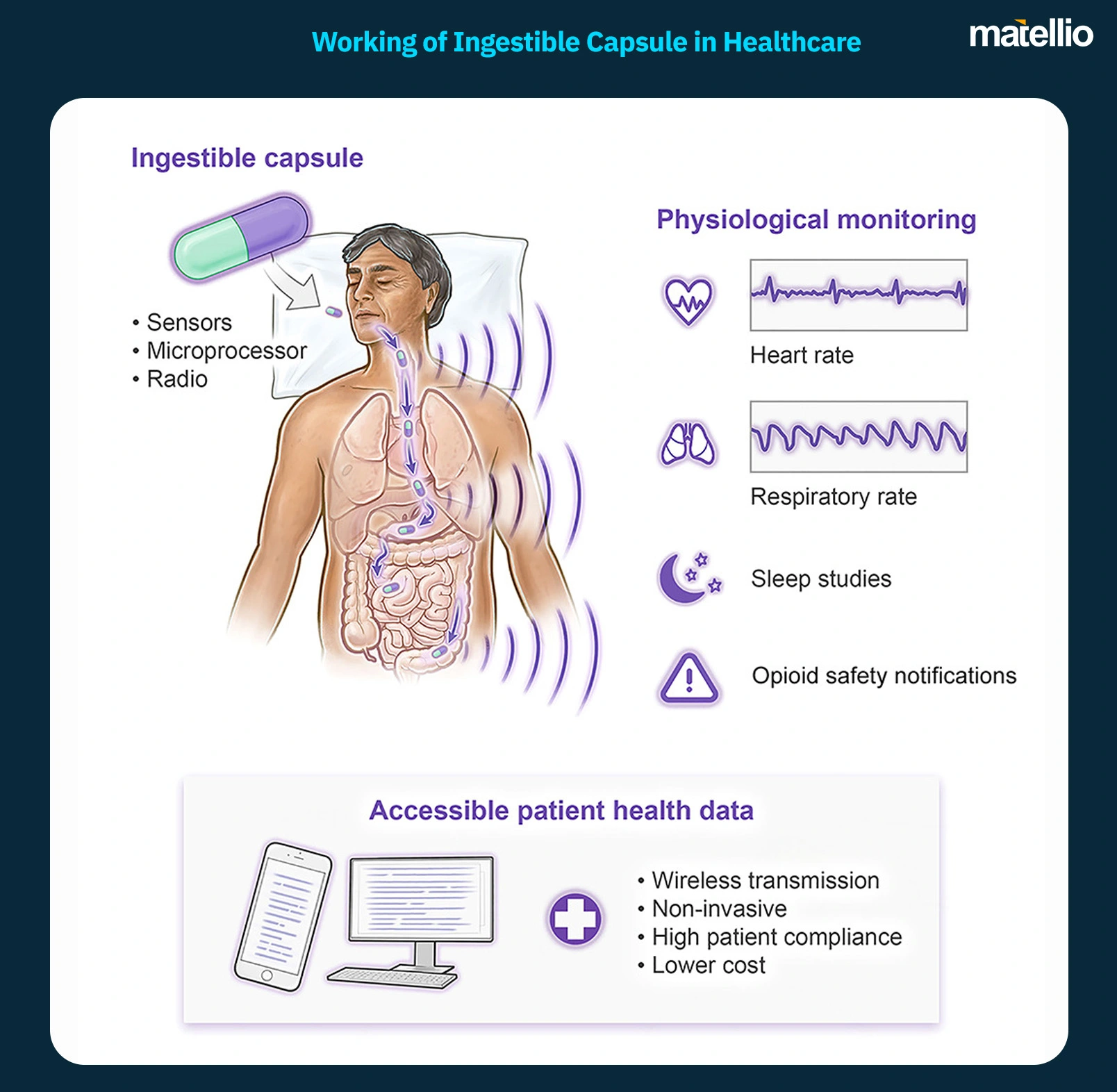
(Source: Cell.com)
The advantages of IoT in healthcare become crystal clear here:
- Improved medication compliance — know if and when meds were taken.
- Early detection of internal complications before symptoms even show.
- Personalized treatment plans based on real-time physiological data.
- Ideal for clinical trials, chronic illness management, and high-risk patient cohorts.
This is no sci-fi fantasy — this is a working example of how IoT applications in healthcare are radically transforming diagnostics and monitoring. If you’re not exploring this space, you’re missing out on a future-ready competitive edge.
Device Health Monitoring: When Machines Save Lives, You Can’t Afford Downtime
Let’s be honest — even the most advanced care can collapse if your medical devices fail when they’re needed most. Whether it’s an MRI machine, infusion pump, or ventilator, one unnoticed glitch can disrupt care, delay diagnoses, or worse — jeopardize patient safety.
That’s why device health monitoring has become one of the most practical and essential IoT use cases in healthcare.
Here’s how it works:
- Critical medical equipment is embedded with IoT sensors that track operating status, usage metrics, and internal diagnostics.
- These sensors send data in real-time to a centralized dashboard or app.
- Your biomedical engineers receive alerts if a device shows early signs of wear, temperature variation, or abnormal power draw — way before failure occurs.
This is automation in healthcare that prevents chaos.
Instead of running on outdated maintenance schedules (or worse, reactive break-fix models), you now have:
- Predictive maintenance for every critical system.
- Fewer device downtimes, ensuring continuous care delivery.
- Extended equipment life spans, saving capital expenditure.
- Improved patient safety and operational readiness.
The advantages of IoT in healthcare don’t stop at patients — they extend to the infrastructure keeping your care running.
Better Clinical Infrastructure Management: Smarter Operations, Better Care
Think about everything that moves within a hospital — patients, beds, wheelchairs, medical staff, surgical tools, lab samples, even medications. Now think about how many hours are lost each day just trying to locate or coordinate them.
That’s not just frustrating — it’s expensive. And preventable.
IoT in healthcare brings precision and control to the chaos through real-time infrastructure tracking and automation.
One standout example? Mt. Sinai Hospital in NYC implemented AutoBed, an IoT-based bed management system that cut ER wait times for inpatient beds by nearly 50%.
Here’s how it works:
- IoT tags (like RFID or BLE beacons) are attached to physical assets — beds, IV pumps, even mobile workstations.
- Smart sensors track occupancy, location, and status in real time.
- The system creates a live digital map of your entire facility — accessible by your staff at any time.
- Advanced analytics tell you how resources are being used, where bottlenecks are happening, and how to fix them.
This kind of application of IoT in healthcare allows you to:
- Reduce patient wait times by optimizing bed allocation.
- Prevent equipment hoarding and overstocking through accurate usage tracking.
- Improve OR scheduling with live visibility into room turnover rates.
- Cut overhead costs by streamlining workflows and reducing manual coordination.
This is where the future of IoT in healthcare lies — not just in patient care, but in reshaping the entire clinical ecosystem for speed, accuracy, and scale.
Want Real-time Visibility Across Your Hospital’s Infrastructure? Let Matellio Help. Contact Us for a Free 30-minute Call!
Implementing IoT in Healthcare Isn’t Easy — And That’s Exactly Why You Need a Specialist
Building a truly connected, data-driven healthcare ecosystem sounds exciting — and it is. But when it comes to actual implementation, the path is full of pitfalls that can stall your progress or risk patient safety if not handled right.
Here’s what healthcare leaders are up against — and why expert IoT development services are essential:
| Challenges of IoT in Healthcare | What an Expert IoT Partner Provides |
| Fragmented systems & lack of interoperability | Seamless integration with EHR, LIS, RIS, PACS, and third-party platforms |
| Data overload with no actionable insights | Built-in analytics and AI integration for real-time decision-making |
| Compliance & patient data privacy concerns (HIPAA, GDPR, etc.) | Secure, HIPAA-compliant architectures with end-to-end encryption |
| Device diversity & compatibility issues | Custom IoMT development services with device-agnostic frameworks |
| Infrastructure limitations (networking, edge computing, etc.) | Scalable cloud + edge solutions tailored to hospital environments |
| High failure rate in scaling pilot projects | Proven methodologies and rapid deployment models |
| Lack of in-house IoT talent or product ownership | Dedicated consulting + full-cycle product ownership from design to deployment |
| Difficulty in maintaining and updating IoT systems | Long-term support, monitoring, and IoT healthcare app development best practices |
Why Expertise Isn’t Optional — It’s the Foundation
IoT in healthcare isn’t just another software build — it’s about merging complex healthcare workflows with advanced connected tech. There are lives on the line, data regulations to follow, and massive systems to integrate.
To get it right, you don’t need more guesswork. You need:
- IoT development services with healthcare-specific expertise
- Knowledge of both clinical processes and technical execution Remove featured image
- The ability to turn strategy into secure, scalable, and real-world applications
That’s where Matellio comes in.
Why Choose Matellio? Because You Can’t Afford to Get IoT in Healthcare Wrong.
If you’re still reading, then you already know the impact of IoT in healthcare is too big to ignore. The question now isn’t if you should act — it’s who you trust to do it right.
That’s where Matellio comes in.
We’re not just developers. We’re your healthcare technology consulting partners and the team that’s going to turn your IoT vision into real, measurable impact.
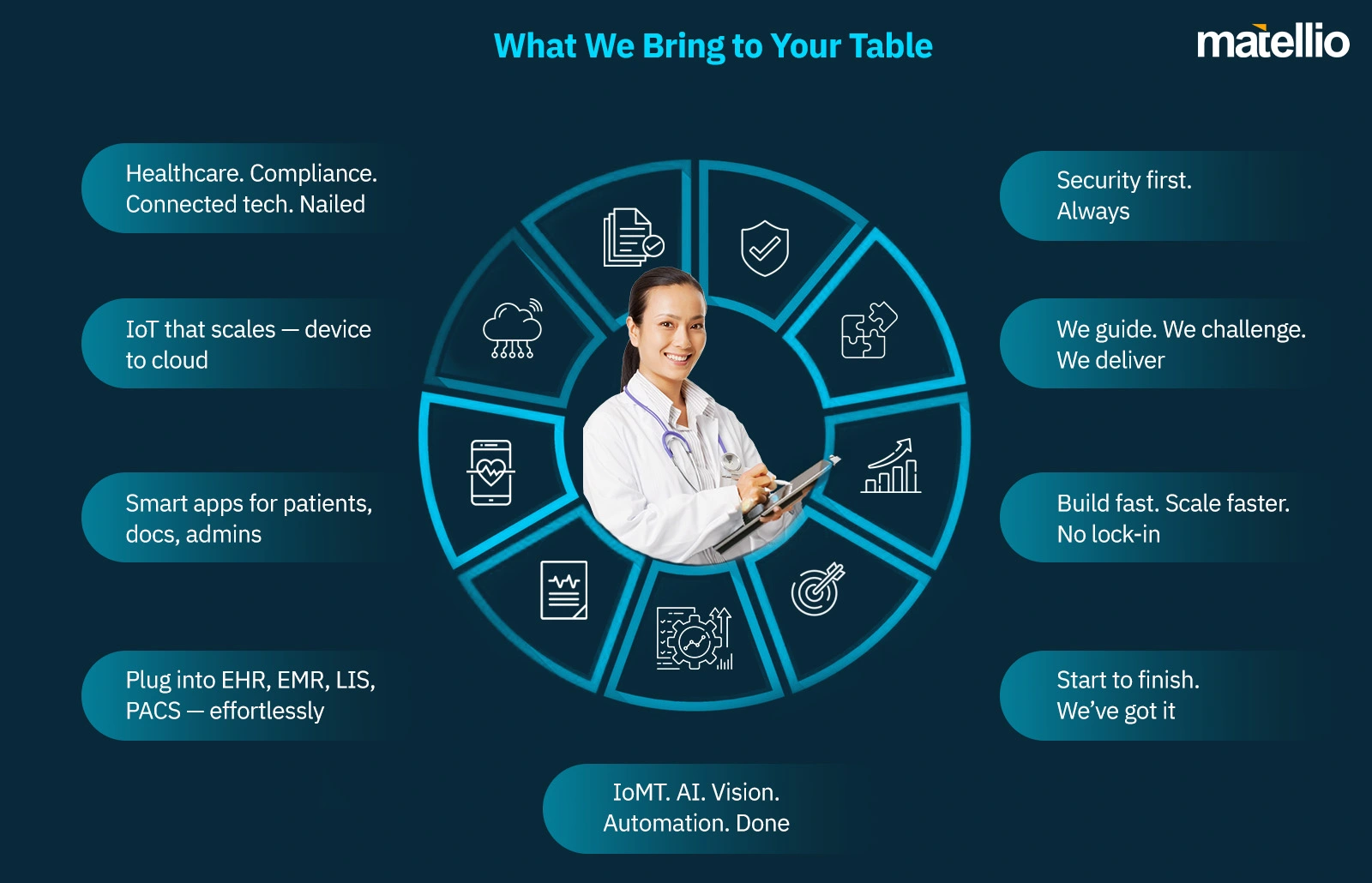
Your hospital or clinic deserves more than a tech vendor. You need a partner who understands your world — the regulations, the risks, the pressures — and delivers with precision.
With Matellio, you get a team that’s done this before. For providers like you. At scale. With results. Whether you need remote patient monitoring, chronic disease management, infrastructure automation, or custom dashboards — we’ll design the IoT in healthcare solution that fits your reality.
Let’s build the future of healthcare — together. Book your free consultation today, and let’s talk about how Matellio can help you digitize, optimize, and lead.
